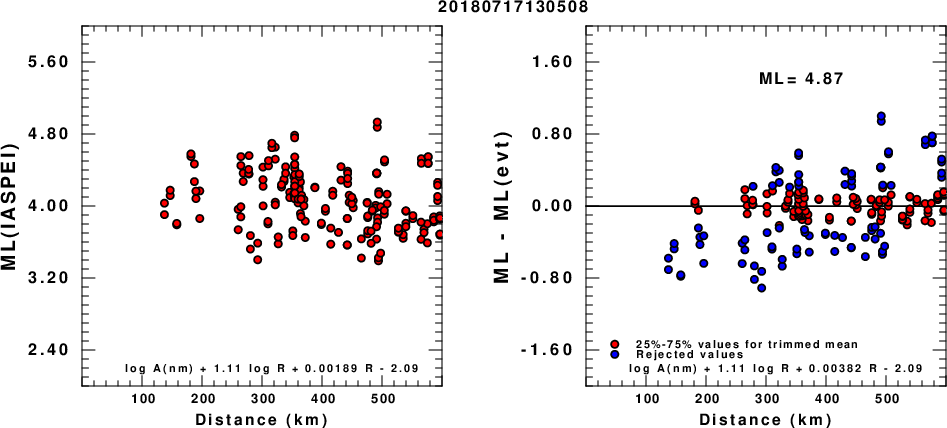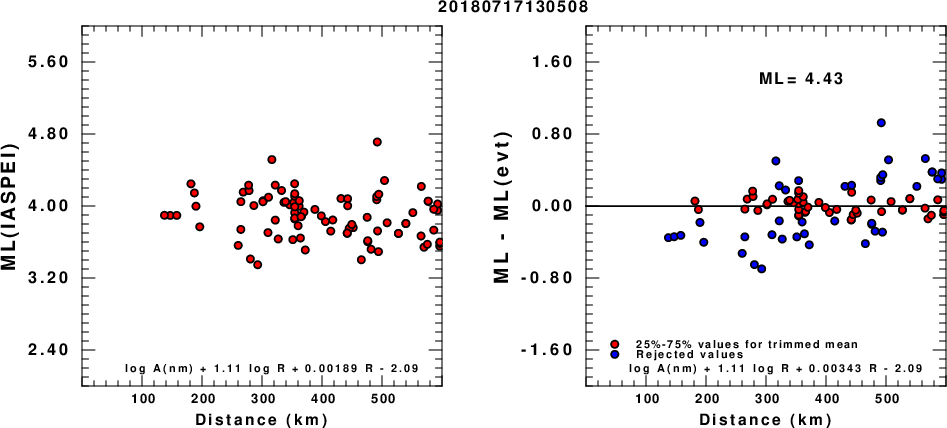Location
Location ANSS
2018/07/17 13:05:08 41.09 19.69 10.0 4.6 Albania
Focal Mechanism
USGS/SLU Moment Tensor Solution
ENS 2018/07/17 13:05:08:4 41.09 19.69 10.0 4.6 Albania
Stations used:
CL.MALA CL.MG05 CL.MG07 HL.EVR HL.JAN HL.KLV HL.KYMI HL.LIA
HL.NEO HL.NVR HL.PLG HL.SMTH HL.THL HL.VLS HL.VLY HP.AMT
HP.ANX HP.GUR HP.PVO HT.AGG HT.ALN HT.AOS2 HT.IGT HT.KAVA
HT.KOKK HT.KRND HT.NEST HT.OUR HT.SIGR HT.SOH HT.THAS
HU.KOVH HU.MORH ME.KOME RO.BZS RO.GZR SJ.FRGS
Filtering commands used:
cut o DIST/3.3 -30 o DIST/3.3 +70
rtr
taper w 0.1
hp c 0.03 n 3
lp c 0.08 n 3
Best Fitting Double Couple
Mo = 2.11e+22 dyne-cm
Mw = 4.15
Z = 27 km
Plane Strike Dip Rake
NP1 152 73 132
NP2 260 45 25
Principal Axes:
Axis Value Plunge Azimuth
T 2.11e+22 45 104
N 0.00e+00 40 317
P -2.11e+22 17 212
Moment Tensor: (dyne-cm)
Component Value
Mxx -1.33e+22
Mxy -1.12e+22
Mxz 2.35e+21
Myy 4.36e+21
Myz 1.33e+22
Mzz 8.93e+21
--------------
#---------------------
####------------------------
#####-------------------------
########--------------------------
#########---#################-------
#########--#######################----
#######-----##########################--
#####--------###########################
####-----------###########################
###-------------##########################
##--------------############## #########
#----------------############# T #########
------------------########### ########
-------------------#####################
-------------------###################
-------------------#################
--------------------##############
---- ------------###########
--- P --------------########
-----------------##
--------------
Global CMT Convention Moment Tensor:
R T P
8.93e+21 2.35e+21 -1.33e+22
2.35e+21 -1.33e+22 1.12e+22
-1.33e+22 1.12e+22 4.36e+21
Details of the solution is found at
http://www.eas.slu.edu/eqc/eqc_mt/MECH.NA/20180717130508/index.html
|
Preferred Solution
The preferred solution from an analysis of the surface-wave spectral amplitude radiation pattern, waveform inversion and first motion observations is
STK = 260
DIP = 45
RAKE = 25
MW = 4.15
HS = 27.0
The NDK file is 20180717130508.ndk
The waveform inversion is preferred.
Moment Tensor Comparison
The following compares this source inversion to others
| SLU |
USGS/SLU Moment Tensor Solution
ENS 2018/07/17 13:05:08:4 41.09 19.69 10.0 4.6 Albania
Stations used:
CL.MALA CL.MG05 CL.MG07 HL.EVR HL.JAN HL.KLV HL.KYMI HL.LIA
HL.NEO HL.NVR HL.PLG HL.SMTH HL.THL HL.VLS HL.VLY HP.AMT
HP.ANX HP.GUR HP.PVO HT.AGG HT.ALN HT.AOS2 HT.IGT HT.KAVA
HT.KOKK HT.KRND HT.NEST HT.OUR HT.SIGR HT.SOH HT.THAS
HU.KOVH HU.MORH ME.KOME RO.BZS RO.GZR SJ.FRGS
Filtering commands used:
cut o DIST/3.3 -30 o DIST/3.3 +70
rtr
taper w 0.1
hp c 0.03 n 3
lp c 0.08 n 3
Best Fitting Double Couple
Mo = 2.11e+22 dyne-cm
Mw = 4.15
Z = 27 km
Plane Strike Dip Rake
NP1 152 73 132
NP2 260 45 25
Principal Axes:
Axis Value Plunge Azimuth
T 2.11e+22 45 104
N 0.00e+00 40 317
P -2.11e+22 17 212
Moment Tensor: (dyne-cm)
Component Value
Mxx -1.33e+22
Mxy -1.12e+22
Mxz 2.35e+21
Myy 4.36e+21
Myz 1.33e+22
Mzz 8.93e+21
--------------
#---------------------
####------------------------
#####-------------------------
########--------------------------
#########---#################-------
#########--#######################----
#######-----##########################--
#####--------###########################
####-----------###########################
###-------------##########################
##--------------############## #########
#----------------############# T #########
------------------########### ########
-------------------#####################
-------------------###################
-------------------#################
--------------------##############
---- ------------###########
--- P --------------########
-----------------##
--------------
Global CMT Convention Moment Tensor:
R T P
8.93e+21 2.35e+21 -1.33e+22
2.35e+21 -1.33e+22 1.12e+22
-1.33e+22 1.12e+22 4.36e+21
Details of the solution is found at
http://www.eas.slu.edu/eqc/eqc_mt/MECH.NA/20180717130508/index.html
|
Magnitudes
ML Magnitude

(a) ML computed using the IASPEI formula for Horizontal components; (b) ML residuals computed using a modified IASPEI formula that accounts for path specific attenuation; the values used for the trimmed mean are indicated. The ML relation used for each figure is given at the bottom of each plot.

(a) ML computed using the IASPEI formula for Vertical components (research); (b) ML residuals computed using a modified IASPEI formula that accounts for path specific attenuation; the values used for the trimmed mean are indicated. The ML relation used for each figure is given at the bottom of each plot.
Context
The next figure presents the focal mechanism for this earthquake (red) in the context of other events (blue) in the SLU Moment Tensor Catalog which are within ± 0.5 degrees of the new event. This comparison is shown in the left panel of the figure. The right panel shows the inferred direction of maximum compressive stress and the type of faulting (green is strike-slip, red is normal, blue is thrust; oblique is shown by a combination of colors).
Waveform Inversion
The focal mechanism was determined using broadband seismic waveforms. The location of the event and the
and stations used for the waveform inversion are shown in the next figure.

|
|
Location of broadband stations used for waveform inversion
|
The program wvfgrd96 was used with good traces observed at short distance to determine the focal mechanism, depth and seismic moment. This technique requires a high quality signal and well determined velocity model for the Green functions. To the extent that these are the quality data, this type of mechanism should be preferred over the radiation pattern technique which requires the separate step of defining the pressure and tension quadrants and the correct strike.
The observed and predicted traces are filtered using the following gsac commands:
cut o DIST/3.3 -30 o DIST/3.3 +70
rtr
taper w 0.1
hp c 0.03 n 3
lp c 0.08 n 3
The results of this grid search from 0.5 to 19 km depth are as follow:
DEPTH STK DIP RAKE MW FIT
WVFGRD96 1.0 185 40 80 3.57 0.1284
WVFGRD96 2.0 190 45 -95 3.68 0.1660
WVFGRD96 3.0 200 40 -85 3.76 0.1882
WVFGRD96 4.0 10 50 -100 3.78 0.1779
WVFGRD96 5.0 320 60 -20 3.68 0.1771
WVFGRD96 6.0 320 65 -25 3.71 0.1868
WVFGRD96 7.0 320 65 -20 3.73 0.1965
WVFGRD96 8.0 315 60 -30 3.79 0.2046
WVFGRD96 9.0 295 55 -20 3.84 0.2129
WVFGRD96 10.0 255 40 15 3.87 0.2224
WVFGRD96 11.0 255 40 15 3.89 0.2342
WVFGRD96 12.0 255 45 20 3.90 0.2458
WVFGRD96 13.0 255 50 25 3.92 0.2591
WVFGRD96 14.0 255 50 25 3.94 0.2733
WVFGRD96 15.0 255 50 25 3.96 0.2869
WVFGRD96 16.0 255 55 25 3.97 0.2999
WVFGRD96 17.0 255 55 25 3.99 0.3118
WVFGRD96 18.0 255 55 25 4.01 0.3226
WVFGRD96 19.0 255 55 25 4.02 0.3326
WVFGRD96 20.0 255 55 25 4.04 0.3414
WVFGRD96 21.0 255 50 25 4.06 0.3485
WVFGRD96 22.0 255 50 25 4.08 0.3550
WVFGRD96 23.0 255 50 25 4.09 0.3598
WVFGRD96 24.0 255 50 25 4.10 0.3636
WVFGRD96 25.0 255 50 20 4.12 0.3663
WVFGRD96 26.0 260 45 25 4.14 0.3683
WVFGRD96 27.0 260 45 25 4.15 0.3692
WVFGRD96 28.0 260 45 25 4.16 0.3691
WVFGRD96 29.0 260 45 25 4.17 0.3682
WVFGRD96 30.0 260 40 20 4.19 0.3663
WVFGRD96 31.0 260 40 20 4.20 0.3647
WVFGRD96 32.0 260 40 20 4.20 0.3621
WVFGRD96 33.0 260 40 20 4.21 0.3597
WVFGRD96 34.0 260 40 20 4.22 0.3566
WVFGRD96 35.0 260 40 20 4.23 0.3531
WVFGRD96 36.0 260 40 20 4.24 0.3495
WVFGRD96 37.0 260 40 15 4.24 0.3454
WVFGRD96 38.0 260 40 15 4.25 0.3408
WVFGRD96 39.0 260 40 20 4.26 0.3353
WVFGRD96 40.0 295 15 65 4.42 0.3305
WVFGRD96 41.0 295 15 65 4.43 0.3256
WVFGRD96 42.0 285 20 55 4.43 0.3199
WVFGRD96 43.0 285 20 55 4.44 0.3138
WVFGRD96 44.0 285 20 55 4.45 0.3072
WVFGRD96 45.0 285 20 60 4.46 0.3006
WVFGRD96 46.0 285 20 60 4.47 0.2938
WVFGRD96 47.0 280 20 55 4.48 0.2867
WVFGRD96 48.0 280 20 55 4.49 0.2794
WVFGRD96 49.0 275 25 50 4.48 0.2719
The best solution is
WVFGRD96 27.0 260 45 25 4.15 0.3692
The mechanism correspond to the best fit is

|
|
Figure 1. Waveform inversion focal mechanism
|
The best fit as a function of depth is given in the following figure:

|
|
Figure 2. Depth sensitivity for waveform mechanism
|
The comparison of the observed and predicted waveforms is given in the next figure. The red traces are the observed and the blue are the predicted.
Each observed-predicted component is plotted to the same scale and peak amplitudes are indicated by the numbers to the left of each trace. A pair of numbers is given in black at the right of each predicted traces. The upper number it the time shift required for maximum correlation between the observed and predicted traces. This time shift is required because the synthetics are not computed at exactly the same distance as the observed and because the velocity model used in the predictions may not be perfect.
A positive time shift indicates that the prediction is too fast and should be delayed to match the observed trace (shift to the right in this figure). A negative value indicates that the prediction is too slow. The lower number gives the percentage of variance reduction to characterize the individual goodness of fit (100% indicates a perfect fit).
The bandpass filter used in the processing and for the display was
cut o DIST/3.3 -30 o DIST/3.3 +70
rtr
taper w 0.1
hp c 0.03 n 3
lp c 0.08 n 3

|
|
Figure 3. Waveform comparison for selected depth
|

|
|
Focal mechanism sensitivity at the preferred depth. The red color indicates a very good fit to thewavefroms.
Each solution is plotted as a vector at a given value of strike and dip with the angle of the vector representing the rake angle, measured, with respect to the upward vertical (N) in the figure.
|
A check on the assumed source location is possible by looking at the time shifts between the observed and predicted traces. The time shifts for waveform matching arise for several reasons:
- The origin time and epicentral distance are incorrect
- The velocity model used for the inversion is incorrect
- The velocity model used to define the P-arrival time is not the
same as the velocity model used for the waveform inversion
(assuming that the initial trace alignment is based on the
P arrival time)
Assuming only a mislocation, the time shifts are fit to a functional form:
Time_shift = A + B cos Azimuth + C Sin Azimuth
The time shifts for this inversion lead to the next figure:

The derived shift in origin time and epicentral coordinates are given at the bottom of the figure.
Discussion
Acknowledgements
Thanks also to the many seismic network operators whose dedication make this effort possible: University of Nevada Reno, University of Alaska, University of Washington, Oregon State University, University of Utah, Montana Bureas of Mines, UC Berkely, Caltech, UC San Diego, Saint Louis University, University of Memphis, Lamont Doherty Earth Observatory, the Iris stations and the Transportable Array of EarthScope.
Velocity Model
The WUS.model used for the waveform synthetic seismograms and for the surface wave eigenfunctions and dispersion is as follows:
MODEL.01
Model after 8 iterations
ISOTROPIC
KGS
FLAT EARTH
1-D
CONSTANT VELOCITY
LINE08
LINE09
LINE10
LINE11
H(KM) VP(KM/S) VS(KM/S) RHO(GM/CC) QP QS ETAP ETAS FREFP FREFS
1.9000 3.4065 2.0089 2.2150 0.302E-02 0.679E-02 0.00 0.00 1.00 1.00
6.1000 5.5445 3.2953 2.6089 0.349E-02 0.784E-02 0.00 0.00 1.00 1.00
13.0000 6.2708 3.7396 2.7812 0.212E-02 0.476E-02 0.00 0.00 1.00 1.00
19.0000 6.4075 3.7680 2.8223 0.111E-02 0.249E-02 0.00 0.00 1.00 1.00
0.0000 7.9000 4.6200 3.2760 0.164E-10 0.370E-10 0.00 0.00 1.00 1.00
Quality Control
Here we tabulate the reasons for not using certain digital data sets
The following stations did not have a valid response files:
Last Changed Wed Jul 18 06:15:52 CDT 2018








